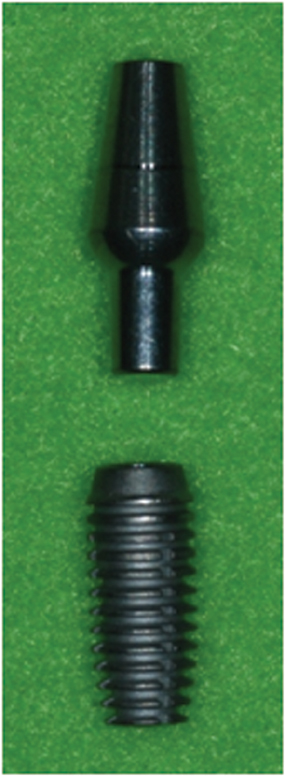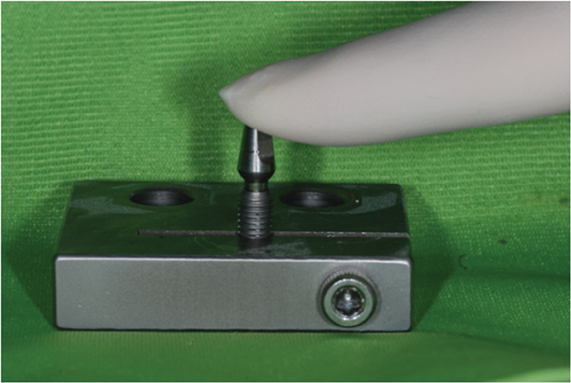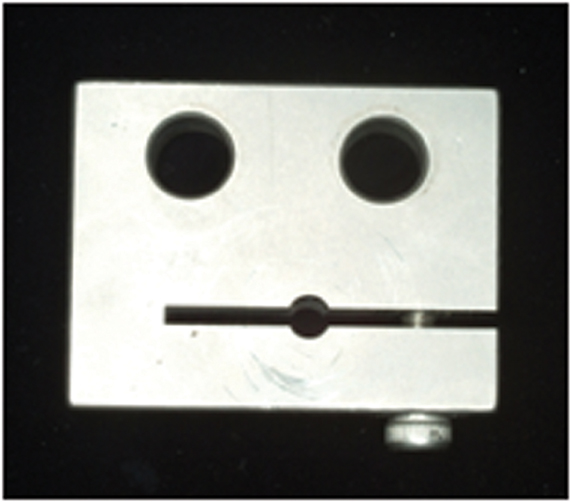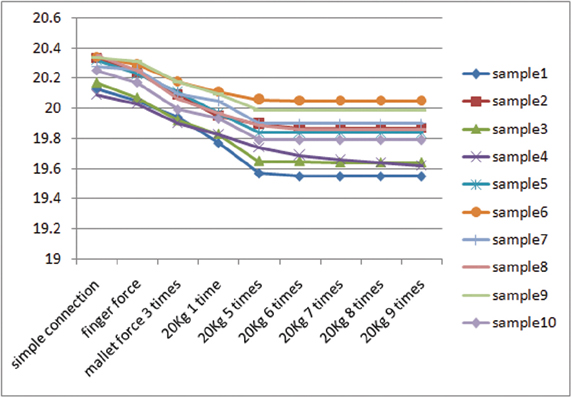J Adv Prosthodont.
2009 Jul;1(2):97-101. 10.4047/jap.2009.1.2.97.
Sinking and fit of abutment of locking taper implant system
- Affiliations
-
- 1Department of Prosthodontics, College of Dentistry, Chosun University, Gwangju, Korea. jhajung@chosun.ac.kr
- KMID: 2045470
- DOI: http://doi.org/10.4047/jap.2009.1.2.97
Abstract
- STATEMENT OF PROBLEM: Unlike screw-retention type, fixture-abutment retention in Locking taper connection depends on frictional force so it has possibility of abutment to sink. PURPOSE: In this study, Bicon(R) Implant System, one of the conical internal connection implant system, was used with applying loading force to the abutments connected to the fixture. Then the amount of sinking was measured. MATERIAL AND METHODS: 10 Bicon(R) implant fixtures were used. First, the abutment was connected to the fixture with finger force. Then it was tapped with a mallet for 3 times and loads of 20 kg corresponding to masticatory force using loading application instrument were applied successively. The abutment state, slightly connected to the fixture without pressure was considered as a reference length, and every new abutment length was measured after each load's step was added. The amount of abutment sinking (mm) was gained by subtracting the length of abutment-fixture under each loading condition from reference length. RESULTS: It was evident, that the amount of abutment sinking in Bicon(R) Implant System increased as loads were added. When loads of 20 kg were applied more than 5 - 7 times, sinking stopped at 0.45 +/- 0.09 mm. CONCLUSION: Even though locking taper connection type implant shows good adaption to occlusal force, it has potential for abutment sinking as loads are given. When locking taper connection type implant is used, satisfactory loads are recommended for precise abutment location.
Figure
Cited by 2 articles
-
Digital evaluation of axial displacement by implant-abutment connection type: An in vitro study
Sung-Jun Kim, KeunBaDa Son, Kyu-Bok Lee
J Adv Prosthodont. 2018;10(5):388-394. doi: 10.4047/jap.2018.10.5.388.Sealing capability and marginal fit of titanium versus zirconia abutments with different connection designs
Nazmiye Şen, Ibrahim Bülent Şermet, Nezahat Gürler
J Adv Prosthodont. 2019;11(2):105-111. doi: 10.4047/jap.2019.11.2.105.
Reference
-
1. Binon PP. Implants and components: entering the new millennium. Int J Oral Maxillofac Implants. 2000. 15:76–94.2. Goodacre CJ, Kan JY, Rungcharassaeng K. Clinical complications of osseointegrated implants. J Prosthet Dent. 1999. 81:537–552.3. Schwarz MS. Mechanical complications of dental implants. Clin Oral Implants Res. 2000. 11:156–158.4. Jemt T, Laney WR, Harris D, Henry PJ, Krogh PH Jr, Polizzi G, Zarb GA, Herrmann I. Osseointegrated implants for single tooth replacement: a 1-year report from a multicenter prospective study. Int J Oral Maxillofac Implants. 1991. 6:29–36.5. Taylor TD. Prosthodontic problems and limitations associated with osseointegration. J Prosthet Dent. 1998. 79:74–78.6. Albrektsson T. A multicenter report on osseointegrated oral implants. J Prosthet Dent. 1988. 60:75–84.7. Keating K. Connecting abutments to Dental implants "An Engineers perspective". Irish Dentist. 2001. 43–46.8. Chapman RJ, Grippo W. The locking taper attachment for implant abutments: use and reliability. Implant Dent. 1996. 5:257–261.9. Gibbs CH, Mahan PE, Lundeen HC, Brehnan K, Walsh EK, Holbrook WB. Occlusal forces during chewing and swallowing as measured by sound transmission. J Prosthet Dent. 1981. 46:443–449.10. Craig Robert G. Restorative Dental Materials. 1980. 6th ed. C.V. Mosby Co;60–62.11. Anderson DJ. Measurement of stress in mastication. I. J Dent Res. 1956. 35:664–670.12. Anderson DJ. Measurement of stress in mastication. II. J Dent Res. 1956. 35:671–673.13. Richter EJ. In vivo vertical forces on implants. Int J Oral Maxillofac Implants. 1995. 10:99–108.14. Van Eijden TM. Three-dimensional analyses of human bite-force magnitude and moment. Arch Oral Biol. 1991. 36:535–539.15. Lee HL, Kim HJ, Son MK, Chung CH. Abutment sinking and fitness of conical internal connection implant system according to loading condition. J Korean Acad Stomatognathic Funct Occlusion. 2008. 24:77–89.16. Dailey B, Jordan L, Blind O, Tavernier B. Axial displacement of abutments into implants and implant replicas, with the tapered cone-screw internal connection, as a function of tightening torque. Int J Oral Maxillofac Implants. 2009. 24:251–256.
- Full Text Links
- Actions
-
Cited
- CITED
-
- Close
- Share
- Similar articles
-
- Fit of fixture/abutment interface of internal connection implant system
- A study of the anti-rotating inner post screw system as a means of preventing abutment screw loosening
- Considerations in implant crestal module to preserve peri-implant tissue
- Fit of fixture/abutment/screw interfaces of internal connection implant system
- Surface change and fit of TiN-coated abutment screw after repeated closing and opening









